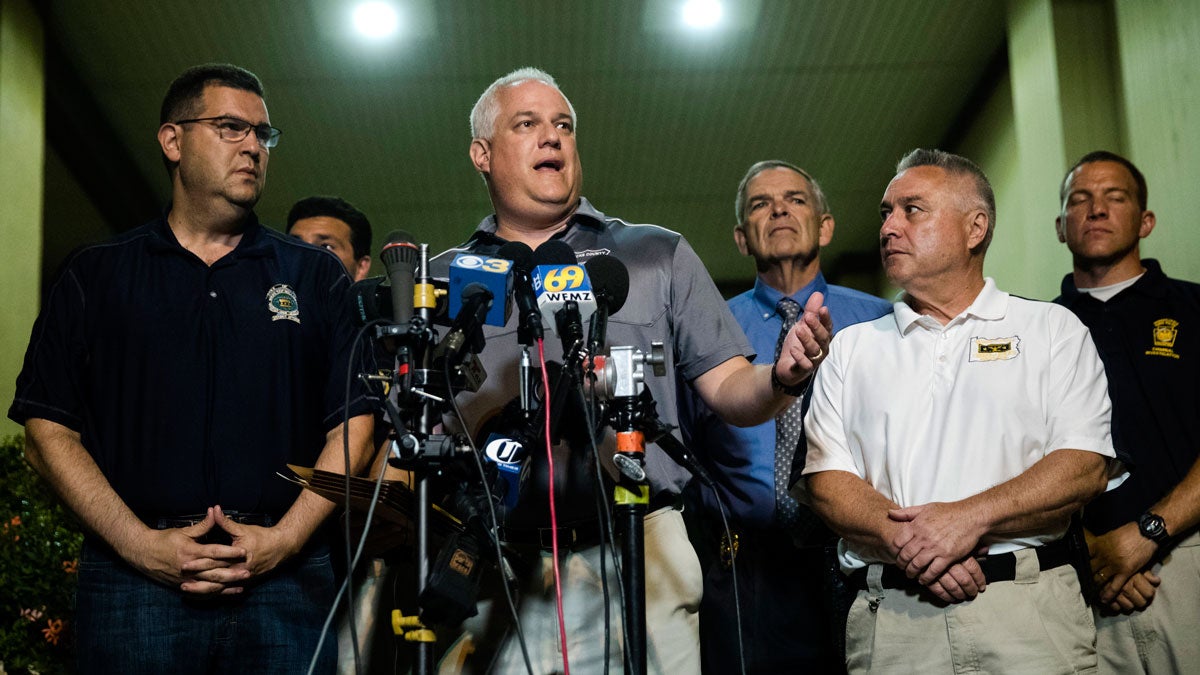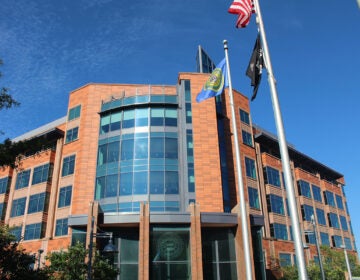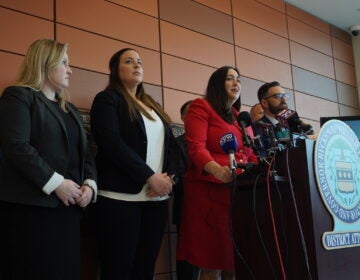Bucks expands program training police to connect people to drug treatment
The idea is to reduce points of friction for people seeking help to get into medical treatment. The program now includes 12 of 39 police departments in Bucks.

Matthew Weintraub, District Attorney for Bucks County, Pa., speaks with members of the media in New Hope, Pa., Thursday, July 13, 2017. (AP Photo/Matt Rourke)
Bucks County is expanding a program designed to quickly get people suffering from addiction connected with treatment by enlisting police departments.
At a press conference in Doylestown Wednesday morning, Fred Harran, director of Public Safety for Bensalem Township, said the goals of the Bucks County Police Assisting in Recovery program, or BPAIR, are straightforward.
“We will get you help immediately, no questions asked,” Harran said of local police departments. “We’re just the ambassadors to put you in contact.”
Harran launched the program in Bensalem three years ago, modeling it after a treatment referral effort set up in Gloucester, Massachusetts. The idea is to reduce points of friction for people in the midst of addiction seeking help to get into medical treatment. To do that, police officers and departments act as a conduit, connecting people quickly with trained volunteers who can arrange for a treatment assessment.
“We want to get folks access to services when they are ready, without a wait,” said Diane Rosati, executive director of the Bucks County Drug and Alcohol Commission.
The program now includes 12 of the 39 police departments in the county, though speakers Wednesday said they expect that number will grow in the coming months. BPAIR’s expansion is funded in part through a $306,254 grant from the Pennsylvania Department of Drug and Alcohol Programs. That money is paying for consulting services, training for police, media materials, as well as drug and alcohol assessments.
Bucks County Commissioner Gene DiGirolamo said that while the region has seen some progress combating the drug epidemic, it isn’t enough.
“This problem is still here,” DiGirolamo said, noting that in addition to opioids, there have been recent upward trends in the use of methamphetamine and cocaine.
He spoke about his own family’s struggle getting his eldest son into treatment more than two decades ago, when DiGirolamo was a state representative. Even with plenty of resources, the family had difficulty navigating how to get him help, how to pay for it, how to get an assessment. All these years later, the process is not so different.
“Families and addicts still struggle today with those questions,” DiGirolamo said.
Programs like BPAIR represent a shift in how law enforcement responds to drug epidemics. And its expansion is coinciding with a nationwide movement to change the role of policing in civil society, with advocates demanding, among other things, that armed police officers not be the first line of response for a broad spectrum of nonviolent social issues like mental illness, homelessness and substance abuse.
Bucks County District Attorney Matt Weintraub called it “a great example of police protecting the public, instead of arresting the ‘technically guilty.’”
The initiative was in motion years before this summer’s wave of protests, though Weintraub says there is some overlap in the various pushes for institutional reform.
“Things have been trending in this direction,” he said, noting that even among members of law enforcement and prosecutors there is an economic argument for guiding people into treatment instead of bringing them into the criminal justice system.
“An ounce of prevention is worth a pound of cure,” Weintraub said.
Bucks County is about 88% white, with a significantly higher median income than the state average, according to the most recent Census figures. Even among supporters of drug and policing reform efforts, there is a growing body of evidence that race and class are playing a major role in the less punitive approaches enacted over the last several years in response to this latest drug epidemic. There are radical racial disparities in access to newer, more effective medications to help curb opioid addiction, with people from whiter, more affluent areas being steered toward them.
“Bias and inequality also help to explain the greater willingness of the public and policymakers to apply a public health framework to the current opioid crisis than to drug use disorders in the past,” said a 2017 report by The Sentencing Project, a nonprofit research and advocacy group. “Not only does the association of this drug crisis with whites help to promote treatment and prevention as policy responses, so too does the greater proximity of white Americans to the policymaking process.”
Officials did not address those points explicitly at Wednesday’s press conference, but in an interview afterward, Weintraub said of race and class, “It enters the discussions, there’s a lot more awareness.”
Those on hand in Doylestown emphasized that BPAIR represents a willingness of communities and individuals all across the county to compassionately collaborate on a complex issue where the status quo solutions have not been effective.
“We are not the experts in all fields,” Harran said of police. “We are not the experts in drug addiction. We are not the experts in mental health. We are not the experts in homelessness. We are not the experts in school district issues. But we are the ambassadors.”
Although only about a third of the county’s police departments are participating in the program so far, officials said residents could go to officers or staff in any jurisdiction to seek help.
”We don’t turn people away,” Harran said.

Get daily updates from WHYY News!
WHYY is your source for fact-based, in-depth journalism and information. As a nonprofit organization, we rely on financial support from readers like you. Please give today.





